Case Study: National Culture, Organisational Behaviour, Leadership
VerifiedAdded on 2020/02/24
|18
|4047
|109
Case Study
AI Summary
This case study delves into the multifaceted relationship between national culture, organizational behavior, and leadership. It examines how cultural factors influence organizational dynamics, including employee behavior, communication, and overall performance. The report explores the impact of cultural convergence, where cultures across different countries become more alike, and its implications for organizations operating globally. The study also analyzes various cultural models, such as those proposed by Edward T. Hall and Geert Hofstede, to understand their significance in effective leadership. The study also explores the impact of internet on culture. The report concludes by discussing how organizations can navigate cultural differences to foster positive and productive work environments. The study also investigates the influence of the internet on cultural exchange and its effects on organizational strategies and employee relations.
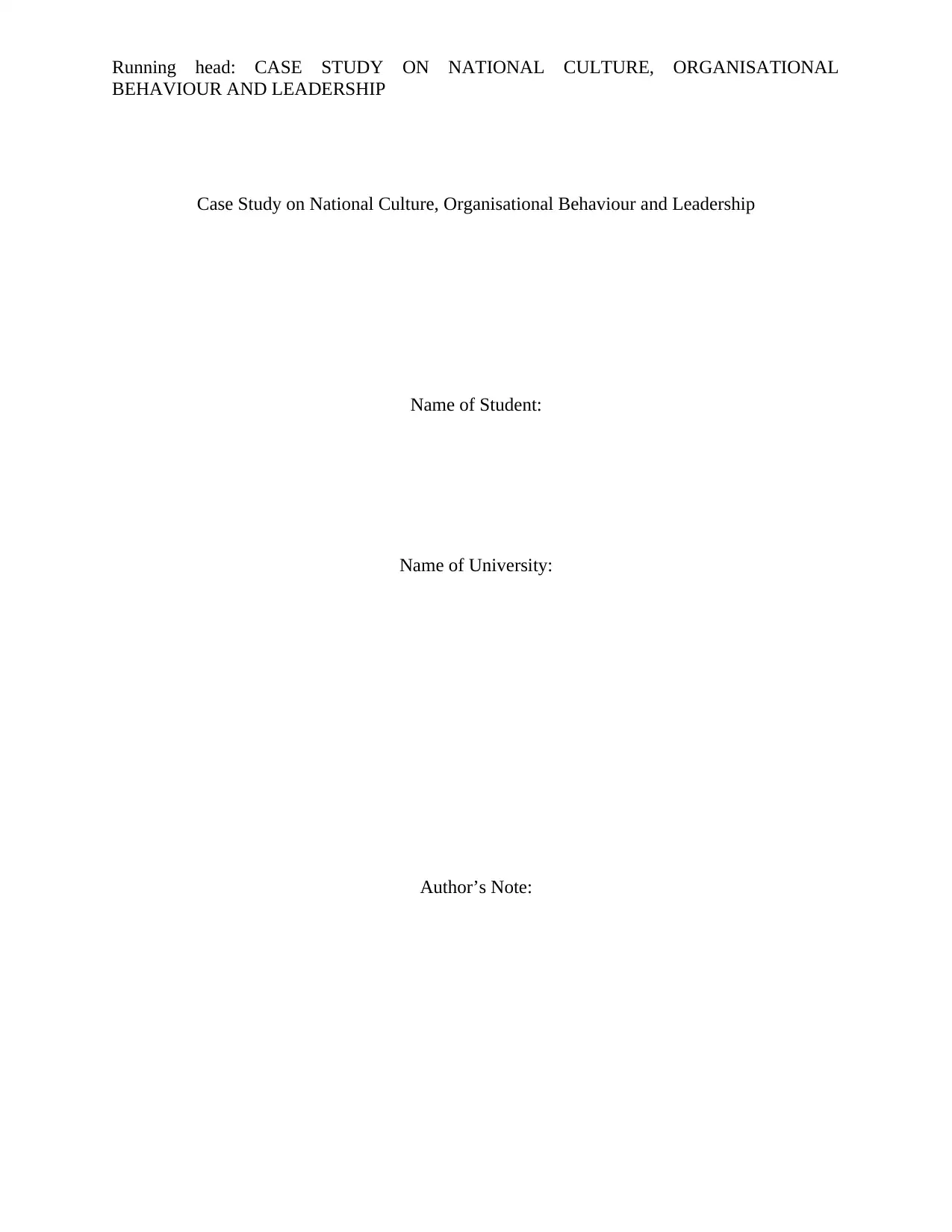
Running head: CASE STUDY ON NATIONAL CULTURE, ORGANISATIONAL
BEHAVIOUR AND LEADERSHIP
Case Study on National Culture, Organisational Behaviour and Leadership
Name of Student:
Name of University:
Author’s Note:
BEHAVIOUR AND LEADERSHIP
Case Study on National Culture, Organisational Behaviour and Leadership
Name of Student:
Name of University:
Author’s Note:
Paraphrase This Document
Need a fresh take? Get an instant paraphrase of this document with our AI Paraphraser
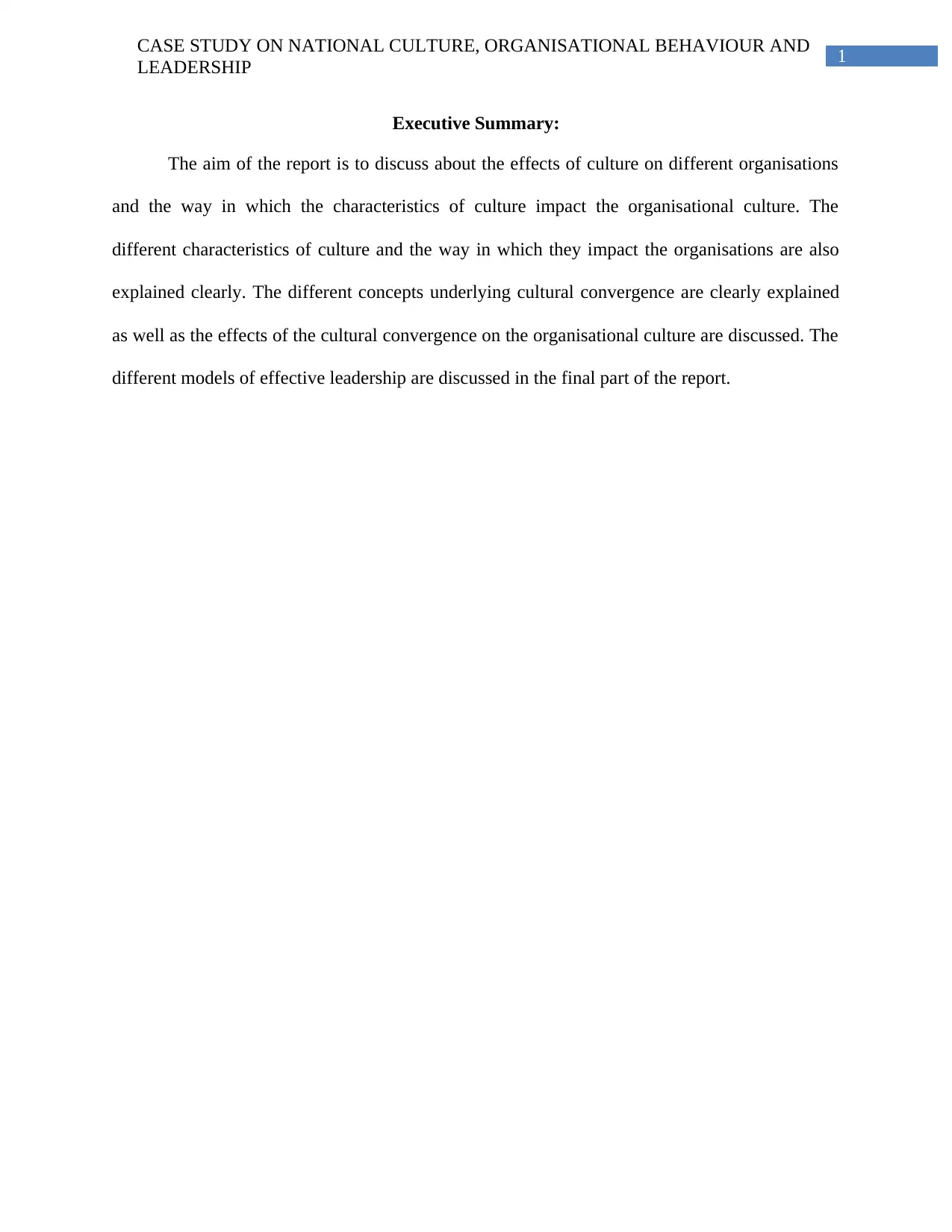
1
CASE STUDY ON NATIONAL CULTURE, ORGANISATIONAL BEHAVIOUR AND
LEADERSHIP
Executive Summary:
The aim of the report is to discuss about the effects of culture on different organisations
and the way in which the characteristics of culture impact the organisational culture. The
different characteristics of culture and the way in which they impact the organisations are also
explained clearly. The different concepts underlying cultural convergence are clearly explained
as well as the effects of the cultural convergence on the organisational culture are discussed. The
different models of effective leadership are discussed in the final part of the report.
CASE STUDY ON NATIONAL CULTURE, ORGANISATIONAL BEHAVIOUR AND
LEADERSHIP
Executive Summary:
The aim of the report is to discuss about the effects of culture on different organisations
and the way in which the characteristics of culture impact the organisational culture. The
different characteristics of culture and the way in which they impact the organisations are also
explained clearly. The different concepts underlying cultural convergence are clearly explained
as well as the effects of the cultural convergence on the organisational culture are discussed. The
different models of effective leadership are discussed in the final part of the report.
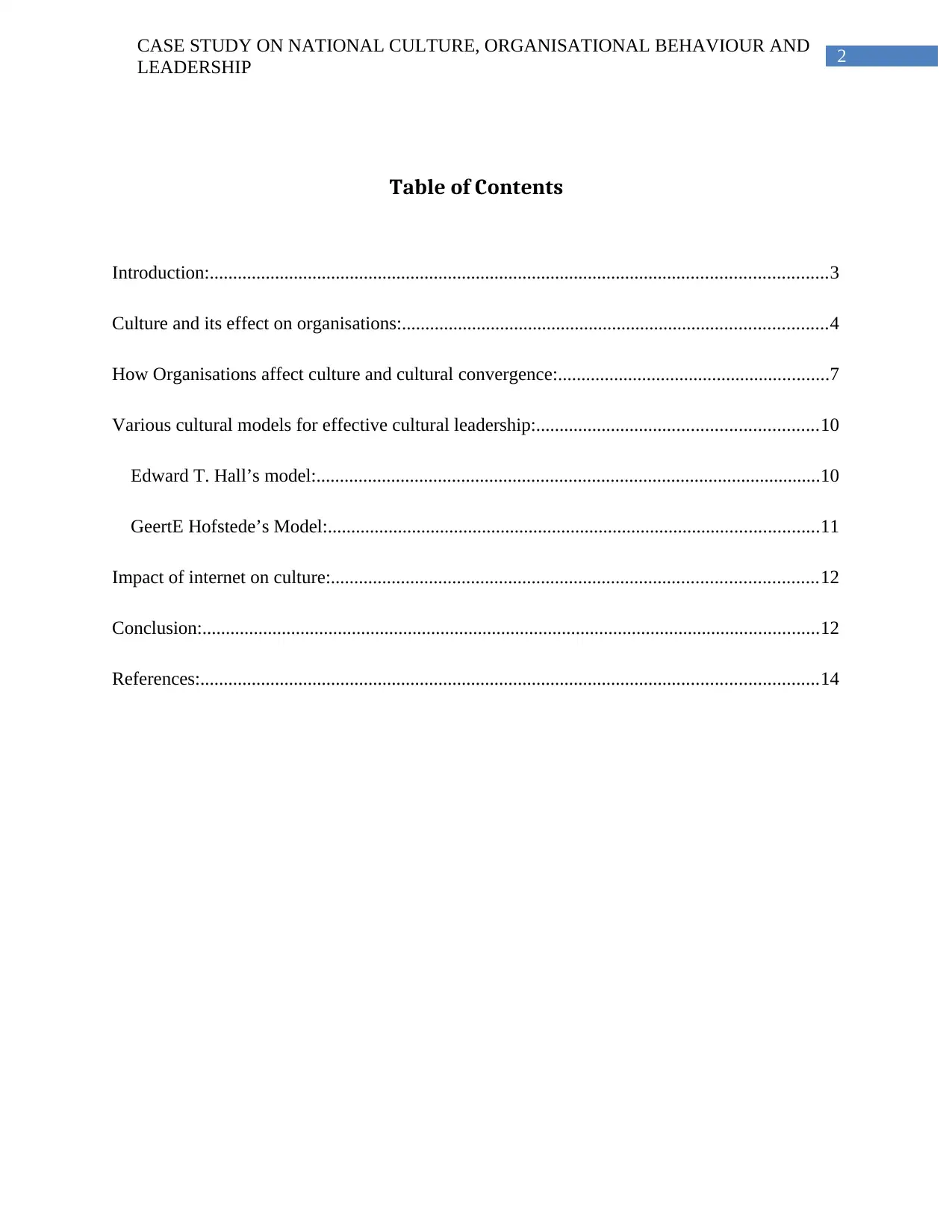
2
CASE STUDY ON NATIONAL CULTURE, ORGANISATIONAL BEHAVIOUR AND
LEADERSHIP
Table of Contents
Introduction:....................................................................................................................................3
Culture and its effect on organisations:...........................................................................................4
How Organisations affect culture and cultural convergence:..........................................................7
Various cultural models for effective cultural leadership:............................................................10
Edward T. Hall’s model:............................................................................................................10
GeertE Hofstede’s Model:.........................................................................................................11
Impact of internet on culture:........................................................................................................12
Conclusion:....................................................................................................................................12
References:....................................................................................................................................14
CASE STUDY ON NATIONAL CULTURE, ORGANISATIONAL BEHAVIOUR AND
LEADERSHIP
Table of Contents
Introduction:....................................................................................................................................3
Culture and its effect on organisations:...........................................................................................4
How Organisations affect culture and cultural convergence:..........................................................7
Various cultural models for effective cultural leadership:............................................................10
Edward T. Hall’s model:............................................................................................................10
GeertE Hofstede’s Model:.........................................................................................................11
Impact of internet on culture:........................................................................................................12
Conclusion:....................................................................................................................................12
References:....................................................................................................................................14
⊘ This is a preview!⊘
Do you want full access?
Subscribe today to unlock all pages.

Trusted by 1+ million students worldwide
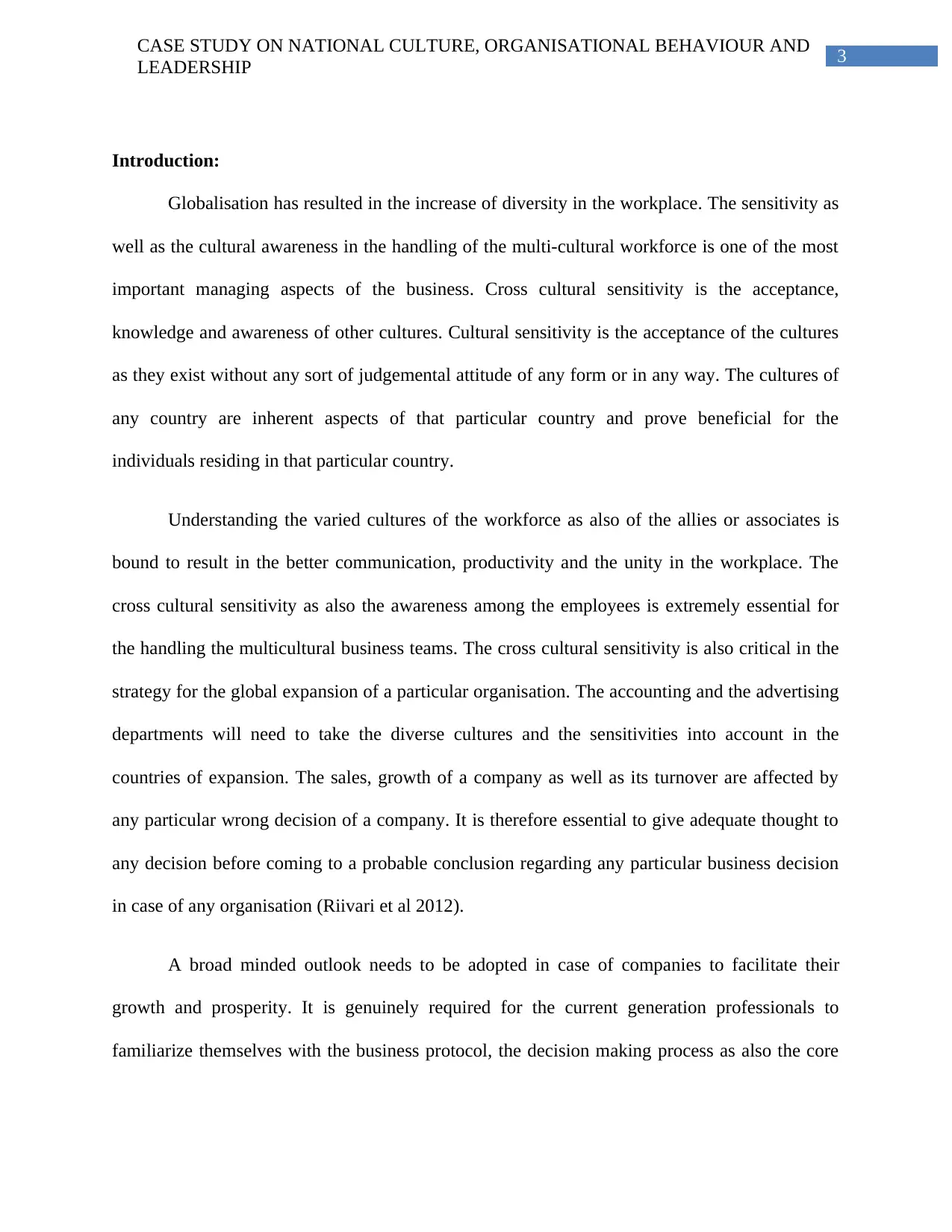
3
CASE STUDY ON NATIONAL CULTURE, ORGANISATIONAL BEHAVIOUR AND
LEADERSHIP
Introduction:
Globalisation has resulted in the increase of diversity in the workplace. The sensitivity as
well as the cultural awareness in the handling of the multi-cultural workforce is one of the most
important managing aspects of the business. Cross cultural sensitivity is the acceptance,
knowledge and awareness of other cultures. Cultural sensitivity is the acceptance of the cultures
as they exist without any sort of judgemental attitude of any form or in any way. The cultures of
any country are inherent aspects of that particular country and prove beneficial for the
individuals residing in that particular country.
Understanding the varied cultures of the workforce as also of the allies or associates is
bound to result in the better communication, productivity and the unity in the workplace. The
cross cultural sensitivity as also the awareness among the employees is extremely essential for
the handling the multicultural business teams. The cross cultural sensitivity is also critical in the
strategy for the global expansion of a particular organisation. The accounting and the advertising
departments will need to take the diverse cultures and the sensitivities into account in the
countries of expansion. The sales, growth of a company as well as its turnover are affected by
any particular wrong decision of a company. It is therefore essential to give adequate thought to
any decision before coming to a probable conclusion regarding any particular business decision
in case of any organisation (Riivari et al 2012).
A broad minded outlook needs to be adopted in case of companies to facilitate their
growth and prosperity. It is genuinely required for the current generation professionals to
familiarize themselves with the business protocol, the decision making process as also the core
CASE STUDY ON NATIONAL CULTURE, ORGANISATIONAL BEHAVIOUR AND
LEADERSHIP
Introduction:
Globalisation has resulted in the increase of diversity in the workplace. The sensitivity as
well as the cultural awareness in the handling of the multi-cultural workforce is one of the most
important managing aspects of the business. Cross cultural sensitivity is the acceptance,
knowledge and awareness of other cultures. Cultural sensitivity is the acceptance of the cultures
as they exist without any sort of judgemental attitude of any form or in any way. The cultures of
any country are inherent aspects of that particular country and prove beneficial for the
individuals residing in that particular country.
Understanding the varied cultures of the workforce as also of the allies or associates is
bound to result in the better communication, productivity and the unity in the workplace. The
cross cultural sensitivity as also the awareness among the employees is extremely essential for
the handling the multicultural business teams. The cross cultural sensitivity is also critical in the
strategy for the global expansion of a particular organisation. The accounting and the advertising
departments will need to take the diverse cultures and the sensitivities into account in the
countries of expansion. The sales, growth of a company as well as its turnover are affected by
any particular wrong decision of a company. It is therefore essential to give adequate thought to
any decision before coming to a probable conclusion regarding any particular business decision
in case of any organisation (Riivari et al 2012).
A broad minded outlook needs to be adopted in case of companies to facilitate their
growth and prosperity. It is genuinely required for the current generation professionals to
familiarize themselves with the business protocol, the decision making process as also the core
Paraphrase This Document
Need a fresh take? Get an instant paraphrase of this document with our AI Paraphraser
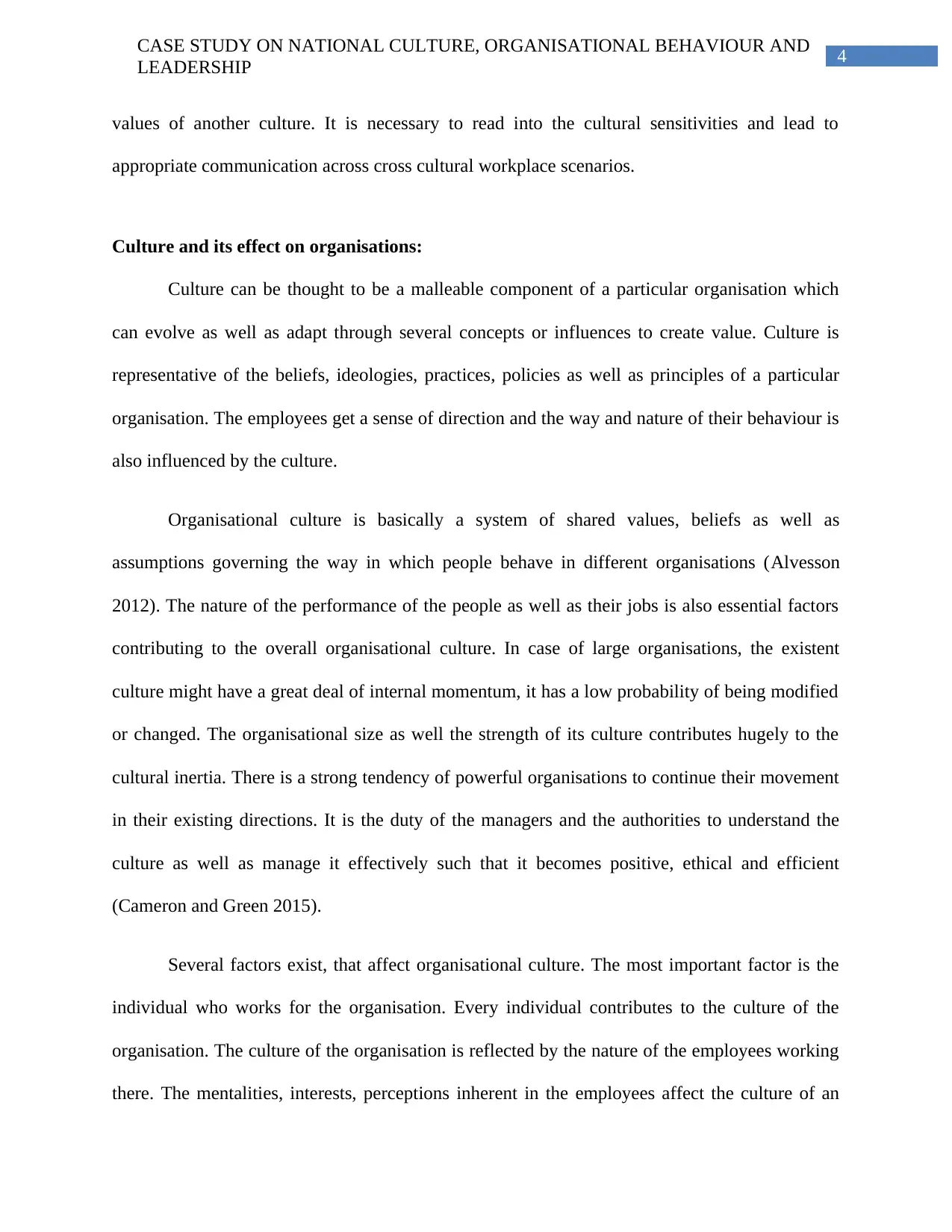
4
CASE STUDY ON NATIONAL CULTURE, ORGANISATIONAL BEHAVIOUR AND
LEADERSHIP
values of another culture. It is necessary to read into the cultural sensitivities and lead to
appropriate communication across cross cultural workplace scenarios.
Culture and its effect on organisations:
Culture can be thought to be a malleable component of a particular organisation which
can evolve as well as adapt through several concepts or influences to create value. Culture is
representative of the beliefs, ideologies, practices, policies as well as principles of a particular
organisation. The employees get a sense of direction and the way and nature of their behaviour is
also influenced by the culture.
Organisational culture is basically a system of shared values, beliefs as well as
assumptions governing the way in which people behave in different organisations (Alvesson
2012). The nature of the performance of the people as well as their jobs is also essential factors
contributing to the overall organisational culture. In case of large organisations, the existent
culture might have a great deal of internal momentum, it has a low probability of being modified
or changed. The organisational size as well the strength of its culture contributes hugely to the
cultural inertia. There is a strong tendency of powerful organisations to continue their movement
in their existing directions. It is the duty of the managers and the authorities to understand the
culture as well as manage it effectively such that it becomes positive, ethical and efficient
(Cameron and Green 2015).
Several factors exist, that affect organisational culture. The most important factor is the
individual who works for the organisation. Every individual contributes to the culture of the
organisation. The culture of the organisation is reflected by the nature of the employees working
there. The mentalities, interests, perceptions inherent in the employees affect the culture of an
CASE STUDY ON NATIONAL CULTURE, ORGANISATIONAL BEHAVIOUR AND
LEADERSHIP
values of another culture. It is necessary to read into the cultural sensitivities and lead to
appropriate communication across cross cultural workplace scenarios.
Culture and its effect on organisations:
Culture can be thought to be a malleable component of a particular organisation which
can evolve as well as adapt through several concepts or influences to create value. Culture is
representative of the beliefs, ideologies, practices, policies as well as principles of a particular
organisation. The employees get a sense of direction and the way and nature of their behaviour is
also influenced by the culture.
Organisational culture is basically a system of shared values, beliefs as well as
assumptions governing the way in which people behave in different organisations (Alvesson
2012). The nature of the performance of the people as well as their jobs is also essential factors
contributing to the overall organisational culture. In case of large organisations, the existent
culture might have a great deal of internal momentum, it has a low probability of being modified
or changed. The organisational size as well the strength of its culture contributes hugely to the
cultural inertia. There is a strong tendency of powerful organisations to continue their movement
in their existing directions. It is the duty of the managers and the authorities to understand the
culture as well as manage it effectively such that it becomes positive, ethical and efficient
(Cameron and Green 2015).
Several factors exist, that affect organisational culture. The most important factor is the
individual who works for the organisation. Every individual contributes to the culture of the
organisation. The culture of the organisation is reflected by the nature of the employees working
there. The mentalities, interests, perceptions inherent in the employees affect the culture of an
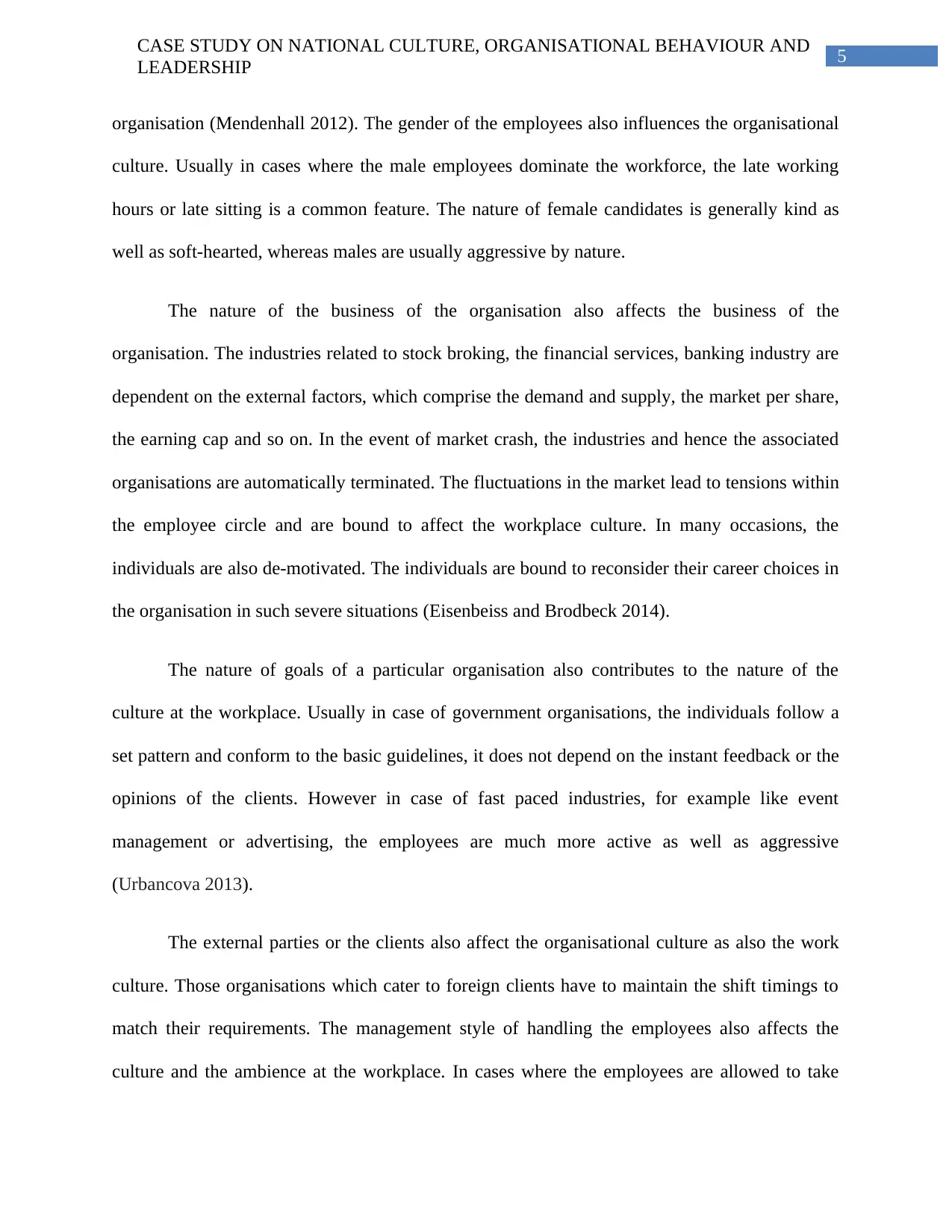
5
CASE STUDY ON NATIONAL CULTURE, ORGANISATIONAL BEHAVIOUR AND
LEADERSHIP
organisation (Mendenhall 2012). The gender of the employees also influences the organisational
culture. Usually in cases where the male employees dominate the workforce, the late working
hours or late sitting is a common feature. The nature of female candidates is generally kind as
well as soft-hearted, whereas males are usually aggressive by nature.
The nature of the business of the organisation also affects the business of the
organisation. The industries related to stock broking, the financial services, banking industry are
dependent on the external factors, which comprise the demand and supply, the market per share,
the earning cap and so on. In the event of market crash, the industries and hence the associated
organisations are automatically terminated. The fluctuations in the market lead to tensions within
the employee circle and are bound to affect the workplace culture. In many occasions, the
individuals are also de-motivated. The individuals are bound to reconsider their career choices in
the organisation in such severe situations (Eisenbeiss and Brodbeck 2014).
The nature of goals of a particular organisation also contributes to the nature of the
culture at the workplace. Usually in case of government organisations, the individuals follow a
set pattern and conform to the basic guidelines, it does not depend on the instant feedback or the
opinions of the clients. However in case of fast paced industries, for example like event
management or advertising, the employees are much more active as well as aggressive
(Urbancova 2013).
The external parties or the clients also affect the organisational culture as also the work
culture. Those organisations which cater to foreign clients have to maintain the shift timings to
match their requirements. The management style of handling the employees also affects the
culture and the ambience at the workplace. In cases where the employees are allowed to take
CASE STUDY ON NATIONAL CULTURE, ORGANISATIONAL BEHAVIOUR AND
LEADERSHIP
organisation (Mendenhall 2012). The gender of the employees also influences the organisational
culture. Usually in cases where the male employees dominate the workforce, the late working
hours or late sitting is a common feature. The nature of female candidates is generally kind as
well as soft-hearted, whereas males are usually aggressive by nature.
The nature of the business of the organisation also affects the business of the
organisation. The industries related to stock broking, the financial services, banking industry are
dependent on the external factors, which comprise the demand and supply, the market per share,
the earning cap and so on. In the event of market crash, the industries and hence the associated
organisations are automatically terminated. The fluctuations in the market lead to tensions within
the employee circle and are bound to affect the workplace culture. In many occasions, the
individuals are also de-motivated. The individuals are bound to reconsider their career choices in
the organisation in such severe situations (Eisenbeiss and Brodbeck 2014).
The nature of goals of a particular organisation also contributes to the nature of the
culture at the workplace. Usually in case of government organisations, the individuals follow a
set pattern and conform to the basic guidelines, it does not depend on the instant feedback or the
opinions of the clients. However in case of fast paced industries, for example like event
management or advertising, the employees are much more active as well as aggressive
(Urbancova 2013).
The external parties or the clients also affect the organisational culture as also the work
culture. Those organisations which cater to foreign clients have to maintain the shift timings to
match their requirements. The management style of handling the employees also affects the
culture and the ambience at the workplace. In cases where the employees are allowed to take
⊘ This is a preview!⊘
Do you want full access?
Subscribe today to unlock all pages.

Trusted by 1+ million students worldwide
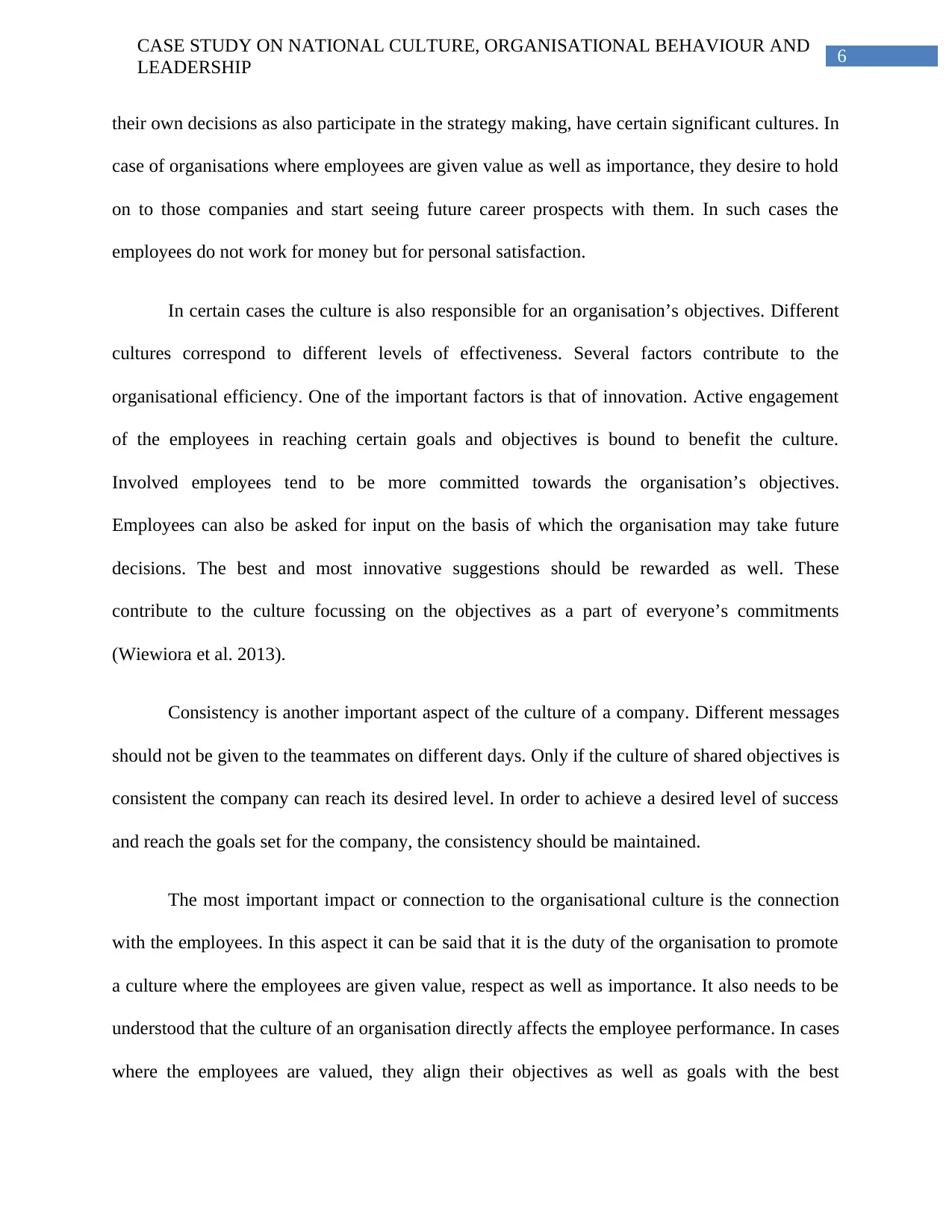
6
CASE STUDY ON NATIONAL CULTURE, ORGANISATIONAL BEHAVIOUR AND
LEADERSHIP
their own decisions as also participate in the strategy making, have certain significant cultures. In
case of organisations where employees are given value as well as importance, they desire to hold
on to those companies and start seeing future career prospects with them. In such cases the
employees do not work for money but for personal satisfaction.
In certain cases the culture is also responsible for an organisation’s objectives. Different
cultures correspond to different levels of effectiveness. Several factors contribute to the
organisational efficiency. One of the important factors is that of innovation. Active engagement
of the employees in reaching certain goals and objectives is bound to benefit the culture.
Involved employees tend to be more committed towards the organisation’s objectives.
Employees can also be asked for input on the basis of which the organisation may take future
decisions. The best and most innovative suggestions should be rewarded as well. These
contribute to the culture focussing on the objectives as a part of everyone’s commitments
(Wiewiora et al. 2013).
Consistency is another important aspect of the culture of a company. Different messages
should not be given to the teammates on different days. Only if the culture of shared objectives is
consistent the company can reach its desired level. In order to achieve a desired level of success
and reach the goals set for the company, the consistency should be maintained.
The most important impact or connection to the organisational culture is the connection
with the employees. In this aspect it can be said that it is the duty of the organisation to promote
a culture where the employees are given value, respect as well as importance. It also needs to be
understood that the culture of an organisation directly affects the employee performance. In cases
where the employees are valued, they align their objectives as well as goals with the best
CASE STUDY ON NATIONAL CULTURE, ORGANISATIONAL BEHAVIOUR AND
LEADERSHIP
their own decisions as also participate in the strategy making, have certain significant cultures. In
case of organisations where employees are given value as well as importance, they desire to hold
on to those companies and start seeing future career prospects with them. In such cases the
employees do not work for money but for personal satisfaction.
In certain cases the culture is also responsible for an organisation’s objectives. Different
cultures correspond to different levels of effectiveness. Several factors contribute to the
organisational efficiency. One of the important factors is that of innovation. Active engagement
of the employees in reaching certain goals and objectives is bound to benefit the culture.
Involved employees tend to be more committed towards the organisation’s objectives.
Employees can also be asked for input on the basis of which the organisation may take future
decisions. The best and most innovative suggestions should be rewarded as well. These
contribute to the culture focussing on the objectives as a part of everyone’s commitments
(Wiewiora et al. 2013).
Consistency is another important aspect of the culture of a company. Different messages
should not be given to the teammates on different days. Only if the culture of shared objectives is
consistent the company can reach its desired level. In order to achieve a desired level of success
and reach the goals set for the company, the consistency should be maintained.
The most important impact or connection to the organisational culture is the connection
with the employees. In this aspect it can be said that it is the duty of the organisation to promote
a culture where the employees are given value, respect as well as importance. It also needs to be
understood that the culture of an organisation directly affects the employee performance. In cases
where the employees are valued, they align their objectives as well as goals with the best
Paraphrase This Document
Need a fresh take? Get an instant paraphrase of this document with our AI Paraphraser
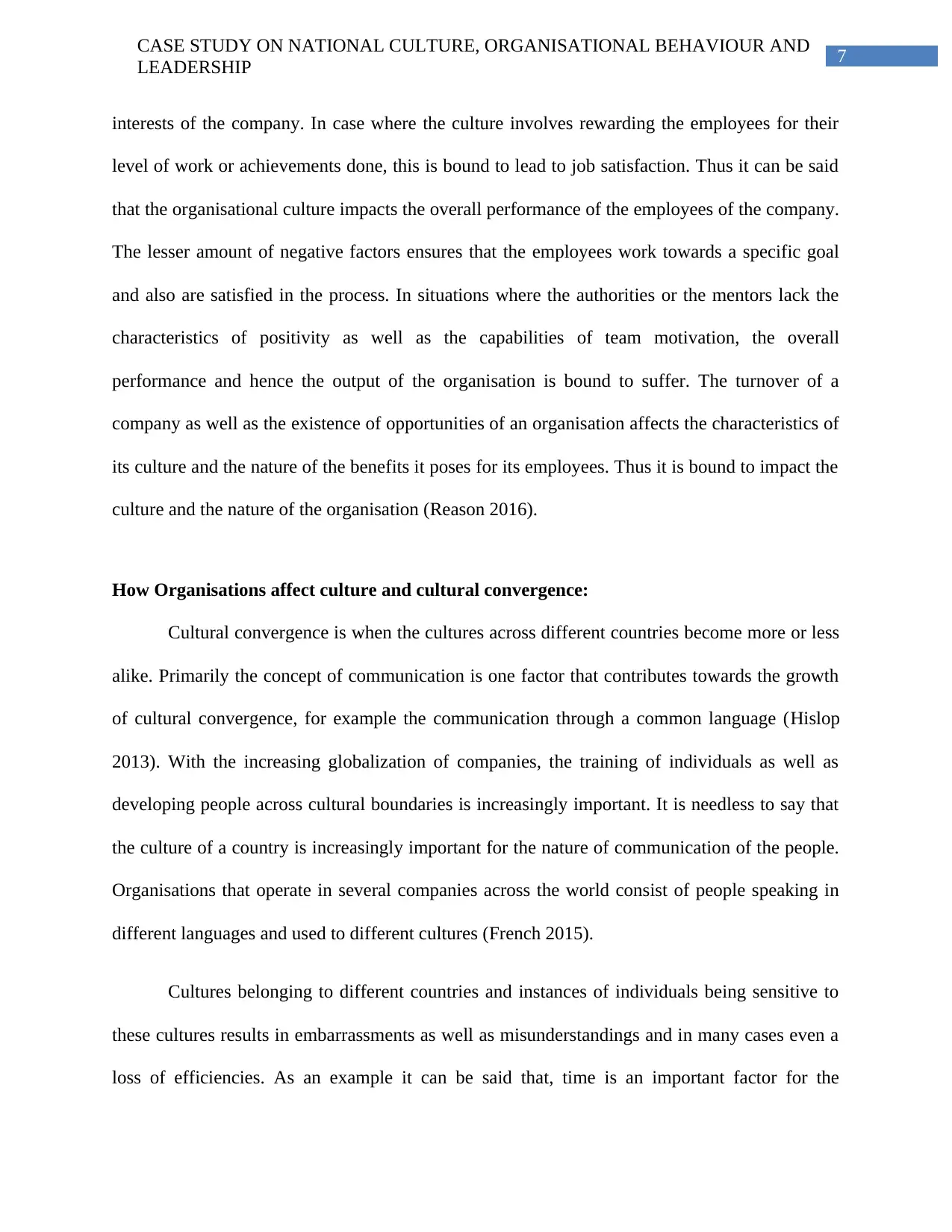
7
CASE STUDY ON NATIONAL CULTURE, ORGANISATIONAL BEHAVIOUR AND
LEADERSHIP
interests of the company. In case where the culture involves rewarding the employees for their
level of work or achievements done, this is bound to lead to job satisfaction. Thus it can be said
that the organisational culture impacts the overall performance of the employees of the company.
The lesser amount of negative factors ensures that the employees work towards a specific goal
and also are satisfied in the process. In situations where the authorities or the mentors lack the
characteristics of positivity as well as the capabilities of team motivation, the overall
performance and hence the output of the organisation is bound to suffer. The turnover of a
company as well as the existence of opportunities of an organisation affects the characteristics of
its culture and the nature of the benefits it poses for its employees. Thus it is bound to impact the
culture and the nature of the organisation (Reason 2016).
How Organisations affect culture and cultural convergence:
Cultural convergence is when the cultures across different countries become more or less
alike. Primarily the concept of communication is one factor that contributes towards the growth
of cultural convergence, for example the communication through a common language (Hislop
2013). With the increasing globalization of companies, the training of individuals as well as
developing people across cultural boundaries is increasingly important. It is needless to say that
the culture of a country is increasingly important for the nature of communication of the people.
Organisations that operate in several companies across the world consist of people speaking in
different languages and used to different cultures (French 2015).
Cultures belonging to different countries and instances of individuals being sensitive to
these cultures results in embarrassments as well as misunderstandings and in many cases even a
loss of efficiencies. As an example it can be said that, time is an important factor for the
CASE STUDY ON NATIONAL CULTURE, ORGANISATIONAL BEHAVIOUR AND
LEADERSHIP
interests of the company. In case where the culture involves rewarding the employees for their
level of work or achievements done, this is bound to lead to job satisfaction. Thus it can be said
that the organisational culture impacts the overall performance of the employees of the company.
The lesser amount of negative factors ensures that the employees work towards a specific goal
and also are satisfied in the process. In situations where the authorities or the mentors lack the
characteristics of positivity as well as the capabilities of team motivation, the overall
performance and hence the output of the organisation is bound to suffer. The turnover of a
company as well as the existence of opportunities of an organisation affects the characteristics of
its culture and the nature of the benefits it poses for its employees. Thus it is bound to impact the
culture and the nature of the organisation (Reason 2016).
How Organisations affect culture and cultural convergence:
Cultural convergence is when the cultures across different countries become more or less
alike. Primarily the concept of communication is one factor that contributes towards the growth
of cultural convergence, for example the communication through a common language (Hislop
2013). With the increasing globalization of companies, the training of individuals as well as
developing people across cultural boundaries is increasingly important. It is needless to say that
the culture of a country is increasingly important for the nature of communication of the people.
Organisations that operate in several companies across the world consist of people speaking in
different languages and used to different cultures (French 2015).
Cultures belonging to different countries and instances of individuals being sensitive to
these cultures results in embarrassments as well as misunderstandings and in many cases even a
loss of efficiencies. As an example it can be said that, time is an important factor for the
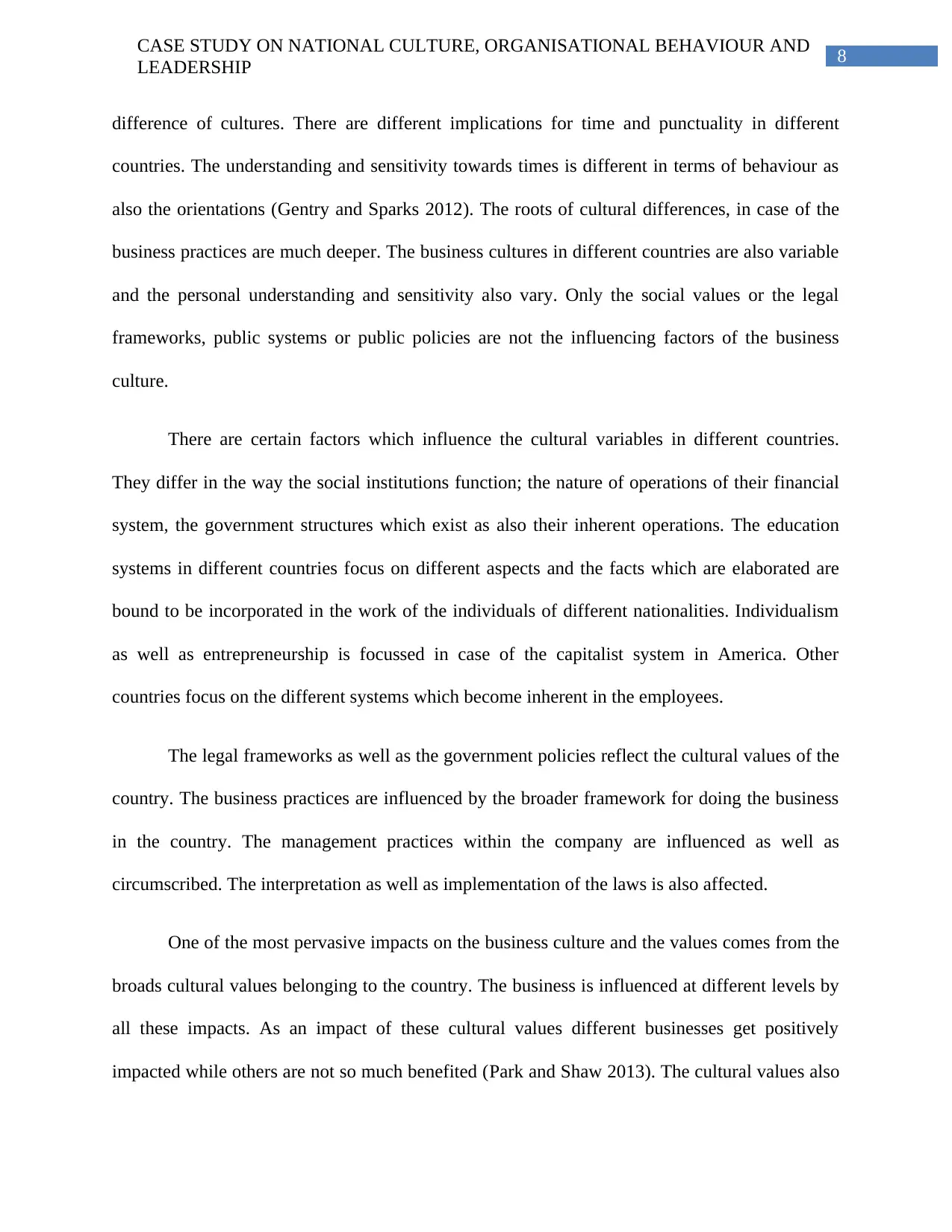
8
CASE STUDY ON NATIONAL CULTURE, ORGANISATIONAL BEHAVIOUR AND
LEADERSHIP
difference of cultures. There are different implications for time and punctuality in different
countries. The understanding and sensitivity towards times is different in terms of behaviour as
also the orientations (Gentry and Sparks 2012). The roots of cultural differences, in case of the
business practices are much deeper. The business cultures in different countries are also variable
and the personal understanding and sensitivity also vary. Only the social values or the legal
frameworks, public systems or public policies are not the influencing factors of the business
culture.
There are certain factors which influence the cultural variables in different countries.
They differ in the way the social institutions function; the nature of operations of their financial
system, the government structures which exist as also their inherent operations. The education
systems in different countries focus on different aspects and the facts which are elaborated are
bound to be incorporated in the work of the individuals of different nationalities. Individualism
as well as entrepreneurship is focussed in case of the capitalist system in America. Other
countries focus on the different systems which become inherent in the employees.
The legal frameworks as well as the government policies reflect the cultural values of the
country. The business practices are influenced by the broader framework for doing the business
in the country. The management practices within the company are influenced as well as
circumscribed. The interpretation as well as implementation of the laws is also affected.
One of the most pervasive impacts on the business culture and the values comes from the
broads cultural values belonging to the country. The business is influenced at different levels by
all these impacts. As an impact of these cultural values different businesses get positively
impacted while others are not so much benefited (Park and Shaw 2013). The cultural values also
CASE STUDY ON NATIONAL CULTURE, ORGANISATIONAL BEHAVIOUR AND
LEADERSHIP
difference of cultures. There are different implications for time and punctuality in different
countries. The understanding and sensitivity towards times is different in terms of behaviour as
also the orientations (Gentry and Sparks 2012). The roots of cultural differences, in case of the
business practices are much deeper. The business cultures in different countries are also variable
and the personal understanding and sensitivity also vary. Only the social values or the legal
frameworks, public systems or public policies are not the influencing factors of the business
culture.
There are certain factors which influence the cultural variables in different countries.
They differ in the way the social institutions function; the nature of operations of their financial
system, the government structures which exist as also their inherent operations. The education
systems in different countries focus on different aspects and the facts which are elaborated are
bound to be incorporated in the work of the individuals of different nationalities. Individualism
as well as entrepreneurship is focussed in case of the capitalist system in America. Other
countries focus on the different systems which become inherent in the employees.
The legal frameworks as well as the government policies reflect the cultural values of the
country. The business practices are influenced by the broader framework for doing the business
in the country. The management practices within the company are influenced as well as
circumscribed. The interpretation as well as implementation of the laws is also affected.
One of the most pervasive impacts on the business culture and the values comes from the
broads cultural values belonging to the country. The business is influenced at different levels by
all these impacts. As an impact of these cultural values different businesses get positively
impacted while others are not so much benefited (Park and Shaw 2013). The cultural values also
⊘ This is a preview!⊘
Do you want full access?
Subscribe today to unlock all pages.

Trusted by 1+ million students worldwide
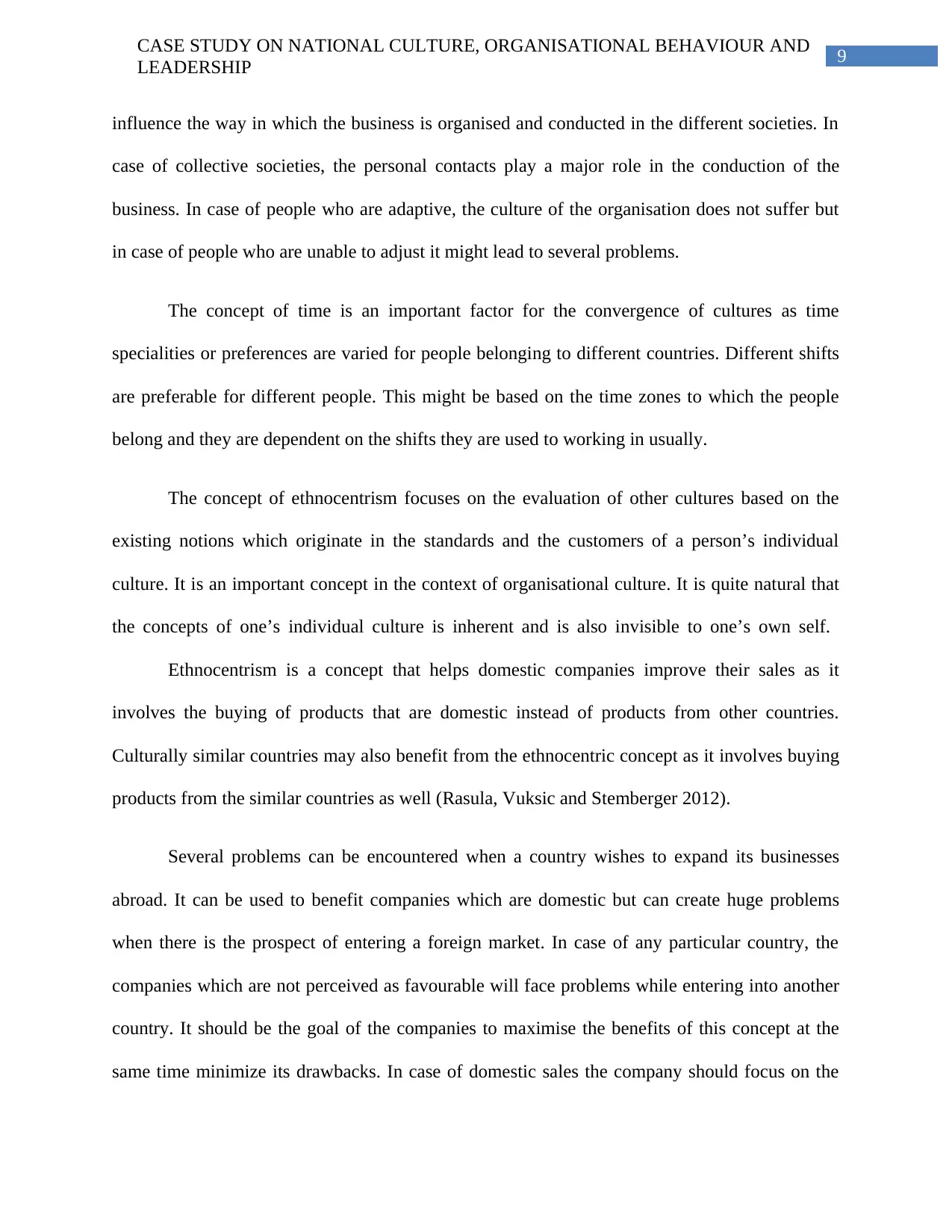
9
CASE STUDY ON NATIONAL CULTURE, ORGANISATIONAL BEHAVIOUR AND
LEADERSHIP
influence the way in which the business is organised and conducted in the different societies. In
case of collective societies, the personal contacts play a major role in the conduction of the
business. In case of people who are adaptive, the culture of the organisation does not suffer but
in case of people who are unable to adjust it might lead to several problems.
The concept of time is an important factor for the convergence of cultures as time
specialities or preferences are varied for people belonging to different countries. Different shifts
are preferable for different people. This might be based on the time zones to which the people
belong and they are dependent on the shifts they are used to working in usually.
The concept of ethnocentrism focuses on the evaluation of other cultures based on the
existing notions which originate in the standards and the customers of a person’s individual
culture. It is an important concept in the context of organisational culture. It is quite natural that
the concepts of one’s individual culture is inherent and is also invisible to one’s own self.
Ethnocentrism is a concept that helps domestic companies improve their sales as it
involves the buying of products that are domestic instead of products from other countries.
Culturally similar countries may also benefit from the ethnocentric concept as it involves buying
products from the similar countries as well (Rasula, Vuksic and Stemberger 2012).
Several problems can be encountered when a country wishes to expand its businesses
abroad. It can be used to benefit companies which are domestic but can create huge problems
when there is the prospect of entering a foreign market. In case of any particular country, the
companies which are not perceived as favourable will face problems while entering into another
country. It should be the goal of the companies to maximise the benefits of this concept at the
same time minimize its drawbacks. In case of domestic sales the company should focus on the
CASE STUDY ON NATIONAL CULTURE, ORGANISATIONAL BEHAVIOUR AND
LEADERSHIP
influence the way in which the business is organised and conducted in the different societies. In
case of collective societies, the personal contacts play a major role in the conduction of the
business. In case of people who are adaptive, the culture of the organisation does not suffer but
in case of people who are unable to adjust it might lead to several problems.
The concept of time is an important factor for the convergence of cultures as time
specialities or preferences are varied for people belonging to different countries. Different shifts
are preferable for different people. This might be based on the time zones to which the people
belong and they are dependent on the shifts they are used to working in usually.
The concept of ethnocentrism focuses on the evaluation of other cultures based on the
existing notions which originate in the standards and the customers of a person’s individual
culture. It is an important concept in the context of organisational culture. It is quite natural that
the concepts of one’s individual culture is inherent and is also invisible to one’s own self.
Ethnocentrism is a concept that helps domestic companies improve their sales as it
involves the buying of products that are domestic instead of products from other countries.
Culturally similar countries may also benefit from the ethnocentric concept as it involves buying
products from the similar countries as well (Rasula, Vuksic and Stemberger 2012).
Several problems can be encountered when a country wishes to expand its businesses
abroad. It can be used to benefit companies which are domestic but can create huge problems
when there is the prospect of entering a foreign market. In case of any particular country, the
companies which are not perceived as favourable will face problems while entering into another
country. It should be the goal of the companies to maximise the benefits of this concept at the
same time minimize its drawbacks. In case of domestic sales the company should focus on the
Paraphrase This Document
Need a fresh take? Get an instant paraphrase of this document with our AI Paraphraser
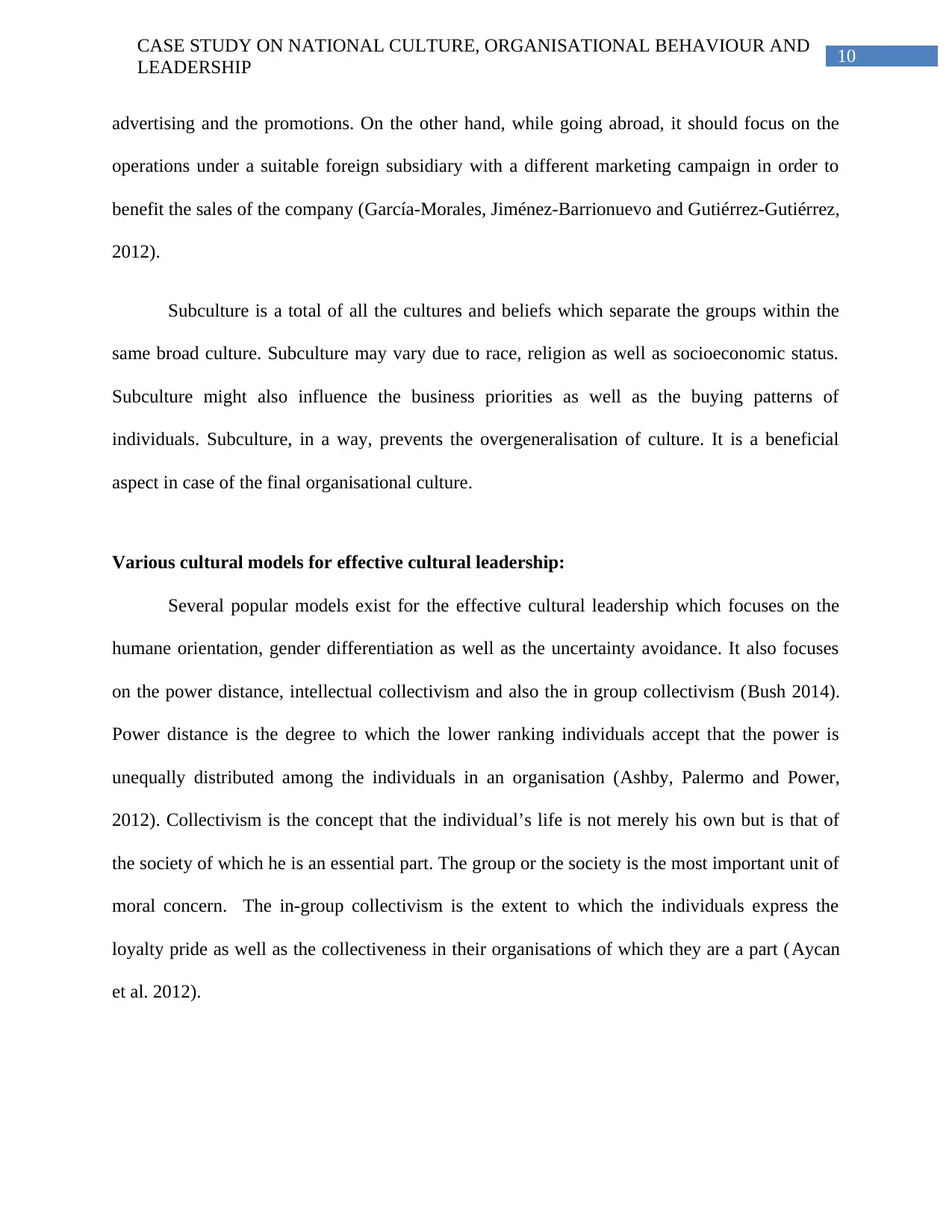
10
CASE STUDY ON NATIONAL CULTURE, ORGANISATIONAL BEHAVIOUR AND
LEADERSHIP
advertising and the promotions. On the other hand, while going abroad, it should focus on the
operations under a suitable foreign subsidiary with a different marketing campaign in order to
benefit the sales of the company (García-Morales, Jiménez-Barrionuevo and Gutiérrez-Gutiérrez,
2012).
Subculture is a total of all the cultures and beliefs which separate the groups within the
same broad culture. Subculture may vary due to race, religion as well as socioeconomic status.
Subculture might also influence the business priorities as well as the buying patterns of
individuals. Subculture, in a way, prevents the overgeneralisation of culture. It is a beneficial
aspect in case of the final organisational culture.
Various cultural models for effective cultural leadership:
Several popular models exist for the effective cultural leadership which focuses on the
humane orientation, gender differentiation as well as the uncertainty avoidance. It also focuses
on the power distance, intellectual collectivism and also the in group collectivism (Bush 2014).
Power distance is the degree to which the lower ranking individuals accept that the power is
unequally distributed among the individuals in an organisation (Ashby, Palermo and Power,
2012). Collectivism is the concept that the individual’s life is not merely his own but is that of
the society of which he is an essential part. The group or the society is the most important unit of
moral concern. The in-group collectivism is the extent to which the individuals express the
loyalty pride as well as the collectiveness in their organisations of which they are a part (Aycan
et al. 2012).
CASE STUDY ON NATIONAL CULTURE, ORGANISATIONAL BEHAVIOUR AND
LEADERSHIP
advertising and the promotions. On the other hand, while going abroad, it should focus on the
operations under a suitable foreign subsidiary with a different marketing campaign in order to
benefit the sales of the company (García-Morales, Jiménez-Barrionuevo and Gutiérrez-Gutiérrez,
2012).
Subculture is a total of all the cultures and beliefs which separate the groups within the
same broad culture. Subculture may vary due to race, religion as well as socioeconomic status.
Subculture might also influence the business priorities as well as the buying patterns of
individuals. Subculture, in a way, prevents the overgeneralisation of culture. It is a beneficial
aspect in case of the final organisational culture.
Various cultural models for effective cultural leadership:
Several popular models exist for the effective cultural leadership which focuses on the
humane orientation, gender differentiation as well as the uncertainty avoidance. It also focuses
on the power distance, intellectual collectivism and also the in group collectivism (Bush 2014).
Power distance is the degree to which the lower ranking individuals accept that the power is
unequally distributed among the individuals in an organisation (Ashby, Palermo and Power,
2012). Collectivism is the concept that the individual’s life is not merely his own but is that of
the society of which he is an essential part. The group or the society is the most important unit of
moral concern. The in-group collectivism is the extent to which the individuals express the
loyalty pride as well as the collectiveness in their organisations of which they are a part (Aycan
et al. 2012).
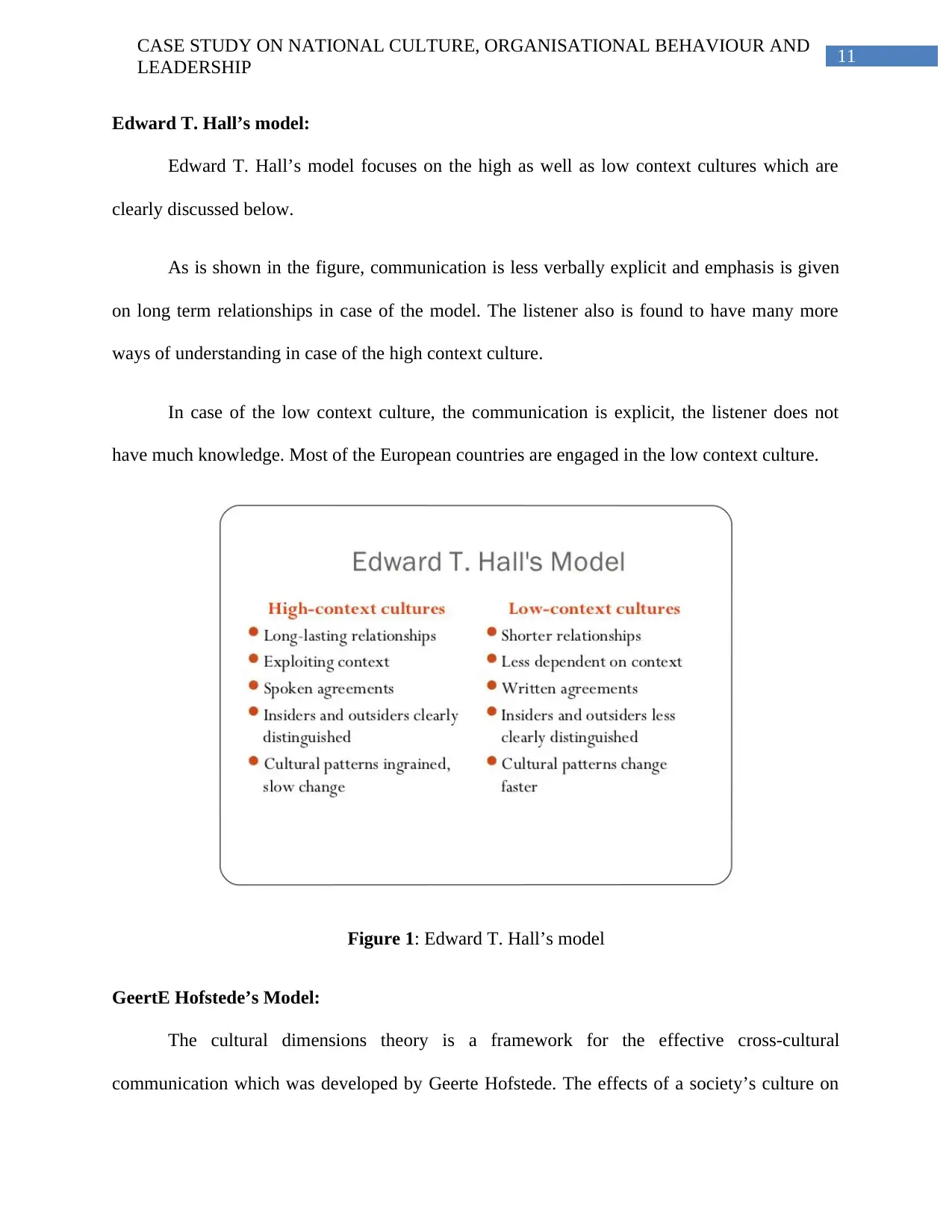
11
CASE STUDY ON NATIONAL CULTURE, ORGANISATIONAL BEHAVIOUR AND
LEADERSHIP
Edward T. Hall’s model:
Edward T. Hall’s model focuses on the high as well as low context cultures which are
clearly discussed below.
As is shown in the figure, communication is less verbally explicit and emphasis is given
on long term relationships in case of the model. The listener also is found to have many more
ways of understanding in case of the high context culture.
In case of the low context culture, the communication is explicit, the listener does not
have much knowledge. Most of the European countries are engaged in the low context culture.
Figure 1: Edward T. Hall’s model
GeertE Hofstede’s Model:
The cultural dimensions theory is a framework for the effective cross-cultural
communication which was developed by Geerte Hofstede. The effects of a society’s culture on
CASE STUDY ON NATIONAL CULTURE, ORGANISATIONAL BEHAVIOUR AND
LEADERSHIP
Edward T. Hall’s model:
Edward T. Hall’s model focuses on the high as well as low context cultures which are
clearly discussed below.
As is shown in the figure, communication is less verbally explicit and emphasis is given
on long term relationships in case of the model. The listener also is found to have many more
ways of understanding in case of the high context culture.
In case of the low context culture, the communication is explicit, the listener does not
have much knowledge. Most of the European countries are engaged in the low context culture.
Figure 1: Edward T. Hall’s model
GeertE Hofstede’s Model:
The cultural dimensions theory is a framework for the effective cross-cultural
communication which was developed by Geerte Hofstede. The effects of a society’s culture on
⊘ This is a preview!⊘
Do you want full access?
Subscribe today to unlock all pages.

Trusted by 1+ million students worldwide
1 out of 18
Related Documents
Your All-in-One AI-Powered Toolkit for Academic Success.
+13062052269
info@desklib.com
Available 24*7 on WhatsApp / Email
![[object Object]](/_next/static/media/star-bottom.7253800d.svg)
Unlock your academic potential
Copyright © 2020–2025 A2Z Services. All Rights Reserved. Developed and managed by ZUCOL.





